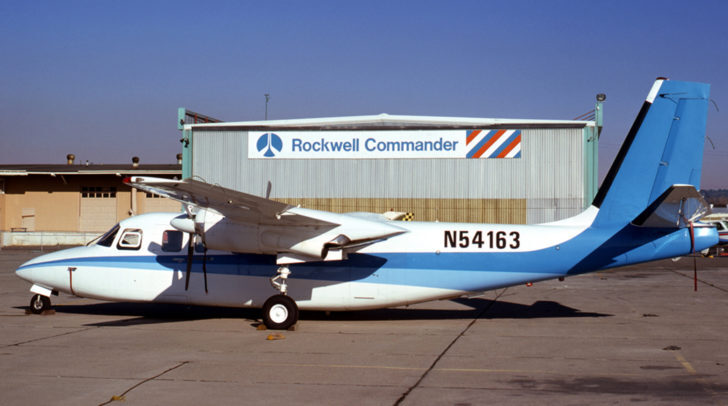By Barry Collman

Originally, N5416, s/n 1774-12 680W had the “Long Ranger” auxiliary fuel tanks installed at the factory, before its Certificate of Airworthiness was issued on June 28, 1968. It was sold to North American Rockwell Corp., in Pittsburgh, Pennsylvania, on July 24, 1968 and on January 14, 1971 was re-registered as N54163. At the time the shot was taken (January 1, 1975) it was registered to Western Airmotive Co Inc., based in Oakland, California. Later, on August 5, 1982, it had Hartzell HC-B3TN-5K/T10178B-13Q Q-Tip propellers installed under STC SA924NW. The following day it was officially signed off as being a Century Turbo when the TPE331-43BL engines were replaced with AiResearch TPE331-1-151Ks. Later still, further modifications were installed—nose recognition lights (June 3, 1987); Commander-Aero winglets (September 26, 1990) and cockpit overhead windows (October 16, 1992). The current owner is Spur Aviation Services LC., of Twin Falls, Idaho.
The Model 680W, named “Turbo II Commander”, was the eighteenth Commander model to be placed into production. The first three were built by the Aero Commander-Bethany Division of Rockwell-Standard Corporation at Wiley Post Airport in Oklahoma City, and the last 43 by the Aero Commander Division of North American Rockwell Corporation.
All 46 680Ws produced were built between February 1968 and December 1969, with serial numbers in the range 1721-1 through 1850-46. Of these, 37 were certified in 1968 and the final nine in 1969.
A factory document describes the Model 680W, under Wing Drawing 5170045 with removed 32-inch wing tip extension, as “identical to the previous Models 680T and 680V in weight, C.G. range, aerodynamic certification, and engine performance; therefore, there is no formal TIA for the 680W. The basic difference between the 680W and 680V is the change to the TPE331-43BL engine. Certification was obtained on February 5, 1968 under the same basis as the 680T. Loads and stress substantiation reports refer to this model as the ‘9400lb’ 680T.”
It also adds, “The 680W is a 9400-lb Turboprop aircraft, which has the internal wing strap except for the first 3 (s/ns 1721, 1722, 1723), which have the external strap. The 680V and 680W are identical structurally, except for the wing lights and strap configuration.”

Originally, N9018N, s/n 1843-42 680W, had auxiliary fuel tanks installed at the factory before its Certificate of Airworthiness was issued on April 12, 1969. It was re-registered as N300CF on April 6, 1971 and on January 3, 1975 it became a Century Turbo with AiResearch TPE331-1-151K engines replacing the original TPE331-43BLs. It was further re-registered as N20ME on November 12, 1977 and then as N20MB on March 13, 1980. A month later, on April 15, 1980 a Wild RC-10 aerial survey camera was installed under STC SA1584SW by Downtown Airpark. Having been re-Registered again as N8416B on July 15, 1980, it was bought by the University of Oklahoma, Department of Aviation and based at Norman, Oklahoma, which changed the registration to the current N940U. The airplane was sold on April 17, 2006 to current owner Sanborn Map Company Inc., of Colorado Springs, Colorado.
The Model 680W was indeed certified on February 5, 1968, under Type Certificate 2A4, and had AiResearch TPE331-43BL engine, each turning the 90-inch-diameter Hamilton Standard 33LF-325/1033A-0 propeller. The “B” in the engine designation indicates a product improvement, while the “L” indicates that the 75-pct low ground idle kit is installed.
Gross weight is 9,400 lb. Cabin pressure differential is 4.2 psi, giving a 13,000-ft cabin at 27,955-ft altitude and a sea level cabin at 9,025-ft altitude.
Some 680Ws have been modified to a “Century Turbo” configuration with the TPE331-43 series engines replaced by the TPE331-1-151K.
The 680W wasn’t built with the “cockpit overhead” or “eyebrow” windows, but at least two have had these installed under Factory Drawing No. 5310418 or STC SA3322WE.
Also, the nose landing lights were replaced with flush-mounted, electrically-operated retractable types located underneath each outboard wing.
Barry Collman’s lifelong interest in airplanes began when he was growing up in a house located underneath the downwind leg to busy Northolt aerodrome, an R.A.F. base near London-Heathrow airport. As a young teenager he discovered airplane “spotting”–hobbyists’ observation and logging of aircraft by make, model, and registration number. The hobby began to grow into a passion as Collman joined a club of like-minded spotters. At one point he purchased a copy of the January 1966 U.S. Civil Aircraft Register, and thumbing through it came upon the Aero Commander. He was hooked. Eventually he acquired every available FAA microfiche file on Commanders, and since 1995 has made annual pilgrimages to Oklahoma City to sift through FAA records. He now has a database with about 100,000 records as well as a collection of negatives, slides, photographs, digital images, magazines, brochures, knick-knacks–and a very understanding wife. This series on Commander production history originally was written for the Twin Commander Flight Group, of which he is an enthusiastic member.
